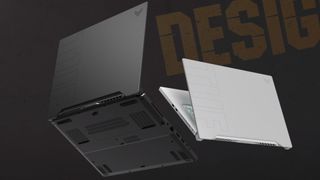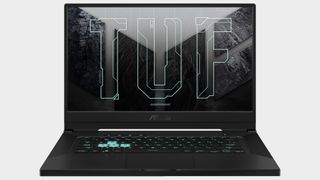12DOVE Verdict
Getting your hands on a 30 series card isn't easy right now so as far as gaming laptops go, this is one of the better options on the market at the moment.
Pros
- +
Solid performance from the GPU and CPU
- +
Thin and portable
- +
Black or white and turquoise color schemes are lovely
Cons
- -
Soft membrane keys
- -
Needs 16GB RAM ideally
Why you can trust 12DOVE
Deciding on the right gaming laptop for you isn't an easy job at the best of times, but now the 30 series of Nvidia graphics cards are on the market, it throws another curveball into the mixer. These pre-built machines are often the only way to reliably get one of the new cards, but how do they perform in a gaming laptop? The ASUS TUF Dash 15 boasts a 3070 – one of the lower-end cards, but still with staggering power – so if high-performance gaming on the go is what you're after, let us take a look at how this performs in our ASUS TUF Dash 15 review and see if it's a contender for best gaming laptop this year.
Design
You can pick up the ASUS TUF Dash 15 in two colors – black or white – and after seeing both, the white one looks sleek as hell. Typically I'll always favor darker shades on my tech, largely because any grubby fingerprints or dirt specks don't show up as easily, but it looks gorgeous on this laptop. Especially with the turquoise LED lights behind the keys.
Inspiring the "Dash" aspect of the laptop is how thin and streamlined it is. Gaming laptops are typically big and bulky beasts that don't channel the spirit of portability too well, but the Dash 15 is just 19.9mm. With that said, it's still quite a heavy device coming in at 2kg exactly, although that is a 10% reduction from prior laptops in the range and fairly light compared to most dedicated gaming laptops. On the exterior, a blocky outline of "TUF" takes up about a third of the lid, with a small logo in one of the opposite corners. The most distinguishing feature when looking at it from the exterior, however, is an indent near the hinge that reveals the status lights – power, battery, and hard drive – without lifting the screen.

Diagonal lines are often associated with speed and again, this helps elevate the "Dash" part of the product. Ridged, angled lines on either side of the keyboard, along with diagonal vents at the top. The keyboard is indented slightly so the keys are at the same level rather than raised, which helps slightly for comfort, but the keys are membrane and not mechanical which may be a downside for you depending on your personal preference or tastes when it comes to the likes of the best gaming keyboard.
On the exterior, a blocky outline of "TUF" takes up about a third of the lid, with a small logo in one of the opposite corners. The most distinguishing feature when looking at it from the exterior, however, is an indent near the hinge that reveals the status lights – power, battery, and hard drive – without lifting the screen.
Features
Processor: Intel i7-11370H
Graphics: Nvidia GeForce RTX 3070
Memory: 8GB DDR4 RAM
Display: 15.6-inch, 240Hz
Resolution: 1920 x 1080
Storage: 1TB NVMe M.2 SSD, 512GB NVMe M.2 SSD
Ports: 1x 3.5mm Combo Audio Jack, 1x HDMI 2.0b, 3x USB 3.2 Gen 1 Type-A, 1x RJ45 LAN port, 1x Thunderbolt™ 4 support DisplayPort™ / power delivery
Connectivity: Wi-Fi 6 (802.11ax) + Bluetooth 5.1 (Dual band) 2*2
OS: Windows 10 Home
Weight: 4.41lbs (2.00kg)
Let's talk specs. On top of the 3070 RTX graphics card – one of the best on the market right now – you're looking at an i7-11370H 3.3 GHz processor. As you'll soon see from the benchmarks in the next section, these two components are the true powerhouses under the hood. They're backed up by 8GB of DDR4 RAM, but with the capacity to upgrade to 32GB, along with two SSDs at 1TB and 500GB each. There are alternate options for a cheaper budget – 3050 or 3060 GPU with an i5-11300H CPU, for example – but this review unit was the high-end spec with that best graphics card contender within it.
The display is fairly standard on the face of it – 15.6" and 1920x1080, the usual for a laptop – but then you look at the refresh rate, which is a whopping 240Hz. This is a rare sight with laptops, so if you're playing a game that can hit 200+ frames-per-second on this beast, then you'll reap the rewards. Unfortunately, it does have a 3ms response time, which means it doesn't achieve the deadly duo of 240Hz and 1ms, but the difference is largely negligible for day-to-day gaming, even if it's very close to offering best gaming monitor spec levels.
The ASUS TUF Dash 15 doesn't skimp on the ports either. There are three USB 3.2 slots, one on the left and two on the right, along with one Thunderbolt, one HDMI 2.0, and an RJ45 LAN port. You've also got a 3.5mm audio jack at the end closest to the user on the left.

Performance
How does the ASUS TUF Dash 15 fare on some industry tests? (All benchmarks completed at 1080p.)
Cinebench CPU: Single Core: 1,381pts | Multi-Core: 6,332pts
3DMark Fire Strike: 17,365pts
3DMark Fire Strike Extreme: 9,870pts
PCMark: 6,022pts
CrystalDiskMark: 3,533 MB/s read; 3,067 MB/s write
Red Dead Redemption 2: Balanced: 63 fps; Max Quality: 57 fps
Tom Clancy's The Division 2: Ultra: 54 fps; High: 86 fps
Metro Exodus: RTX (ray-tracing on Ultra): 51 fps; High: 72 fps
Shadow of the Tomb Raider: Highest: 60 fps; High: 79 fps
Total War: Warhammer II: Ultra: 63 fps; High: 82 fps
With those components under the hood, you know for a fact that the ASUS TUF Dash 15 is going to flourish. The only downside is being limited to 8GB of memory from the get-go because doubling that to 16GB would improve the situation enormously. With that said, let's take a look at some of the benchmarking results from our various tests.
Kicking things off are the 3DMark Fire Strike and Fire Strike Extreme results which are a great showcase of just how powerful this thing is graphically. On the other hand, the Cinebench and PCMark scores are solid examples of what the machine can do with CPU-intensive programs and multitasking.

In the various game benchmarks we ran, you're going to want to tweak and finetune the settings rather than running with the default presets, simply because despite having a 3070, it's not getting anywhere close to utilising that 240Hz display - only the most powerful portables or even the best gaming PCs really push a display that hard. With that said, you'll be hitting 60fps+ in most games as long as you're happy not playing everything maxed out.
Metro Exodus struggled with RTX on, but turn it off and you'll hit a fairly consistent 70+ frames-per-second, while Shadow of the Tomb Raider takes that a little higher, nearing the 80 mark. The Division 2 disappointed a little on ultra, only just managing to surpass 50, but impressed a lot on high with close to 90 fps on average.
With the caveat that the game was built to run on even the lowest spec machines, Valorant plays and looks a dream. For a game like that, the 240Hz display really shines because of the quick, twitchy gunplay. On Apex Legends, the situation was the same; smooth gameplay and a bright, vivid picture that allowed for easy spotting of enemies across the map.
When it comes to things like the battery life and the touchpad, they're much less important in gaming laptops. For proper gaming, you'll be plugging in the best gaming mouse and having the laptop on charge while you play rather than relying solely on battery power, so while neither are anything to write home about, they shouldn't be a major factor in a purchasing decision.

Overall - should you buy it?
As far as gaming laptops go, this is one of the better ones on the market at the moment without having too obscene a price tag. These top-end specs will set you back about $1,300-$1,500 (or pounds) depending on where has it in stock at the time of purchase, but downgrading to an i5 or a 3060 can save you some cash at the expense of sacrificing some performance. Gaming laptops are one of the only ways to access 30 series cards right now though, which instantly works in its favor. You can't really go wrong here, although, without the ability to upgrade to a 3080, it doesn't quite have the groundbreaking performance we were hoping for. But still, this is a quality RTX 3070 laptop.
Give me a game and I will write every "how to" I possibly can or die trying. When I'm not knee-deep in a game to write guides on, you'll find me hurtling round the track in F1, flinging balls on my phone in Pokemon Go, pretending to know what I'm doing in Football Manager, or clicking on heads in Valorant.















